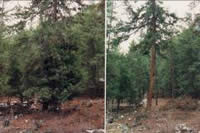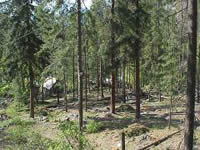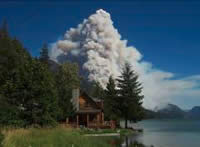
National Fire Plan Success Story
Defensible Space Makes a Difference -
Fuel Reduction Protects Community from Flick Creek Fire
Lake Chelan National Recreation Area, Washington
National Fire Plan - Fuels Reduction
 Left: Mistletoe-infected Douglas-fir before treatment. NPS photo by Andris Vezis. Right: Douglas fir after treatment. NPS photo by Jesse Kennedy.
Left: Mistletoe-infected Douglas-fir before treatment. NPS photo by Andris Vezis. Right: Douglas fir after treatment. NPS photo by Jesse Kennedy.

Tree thinning around homes. NPS photo.

2006 Flick Creek Fire. NPS photo.
Threatened by Wildfire
When residents of the Stehekin Landing were evacuated on September 9, 2006, they didn't know if they would return and have a home. The Flick Creek Fire had been burning since July 26 and was moving toward the community through excessive fuel loadings in extremely steep terrain. Fire suppression tactics relied on using defensible space projects accomplished by the NPS and the community to prevent the destruction of homes, administrative structures, and valuable community infrastructure. Direct attack by ground personnel on this fire was not possible until the weather changed in mid- September.
The fire was ignited mid-slope above Lake Chelan by an illegal campfire, and quickly became a very dangerous, rapidly spreading crown fire which required mandatory evacuation of nearby structures. Fortunately, an active fuel reduction program had been in place around the Stehekin Landing since 1995. If the same fire had occurred 10 years ago, the outcome would have been quite different. As a result of thinning and burning to create shaded fuelbreaks around homes and other structures prior to the fire, no structures were burned and only very minor injuries occurred during the fire suppression effort.
Being Prepared
The 1994 Stehekin Forest Fuel and Firewood Management Plan originally identified a series of prescribed fire and thinning treatments to create strategic fuelbreaks on National Park Service managed land adjacent to private property. As a result of the National Fire Plan, hazardous fuel reduction programs were accelerated, and 120 acres of fuel reduction was completed at the Stehekin Landing. These treatments involved thinning overstocked tree stands, removing unstable diseased trees, and limbing mistletoe infected branches on live trees. The large diameter trees that were thinned were cut into firewood. The branch wood and mistletoe brooms were piled and burned. All of these efforts made it possible to successfully and safely protect 60 structures, including structures listed on the national historic register and NPS administrative sites, at the Stehekin Landing during the Flick Creek Fire.
Forest Health
The forest around Stehekin had grown dense since the last major wildfire in 1890. Numerous fires since that time had threatened Stehekin but had been effectively suppressed before they entered the community. By excluding fire from this ecosystem, the forest had become dominated by thick, young Douglas fir in places where large old trees had once been mixed more evenly with ponderosa pine. With the increase in Douglas fir, parasitic dwarf mistletoe (Arceuthobium douglasii) populations had expanded and fungal root diseases had spread. Large growths of mistletoe on tree branches created ladder fuels. The combination of excessive ladder fuels and ground fuels enabled the Flick Creek Fire to move quickly through the canopy of the overstory trees in areas that had not been treated. Where mistletoe infected branches had been removed, fire behavior was less extreme. The mistletoe removal was done with assistance from the Wenatchee Forestry Sciences Lab which provides expertise and funding to treat forest health problems in the Pacific Northwest.
During eight years of work on the Landing Forest Health Thinning Project, 1,500 understory trees were removed, 700 trees were limbed and 650 overstory trees were cut and utilized by the NPS and valley residents.
Surviving the Flick Creek Fire
The combination of burning, tree thinning, and branch removal in the Landing Forest Health Thinning Project created tree crown separation, and low fuel loads in both the understory and the overstory. As a result, the Flick Creek Fire was easier to control when it got closer to Stehekin Landing. Handlines were easy to construct, simple burn out tactics could be used, and the defensible space created by reducing hazardous fuels provided a safe area for firefighters to work as the fire approached structures. The efforts of property owners along the lakeshore and at the landing to create defensible space around their homes also played a critical role in the outcome the Flick Creek Fire. All of the structures that were threatened survived.
Contact: Tod Johnson, Fire Management Officer
Phone: (360) 854-7350